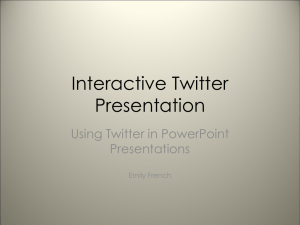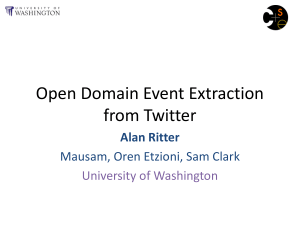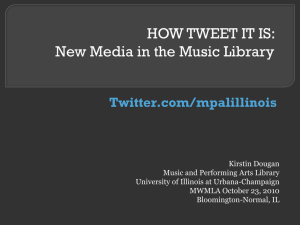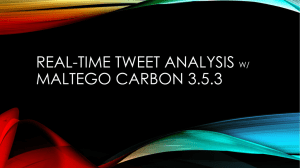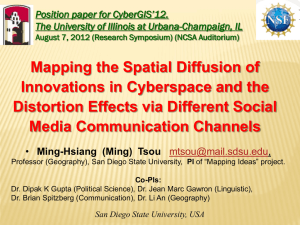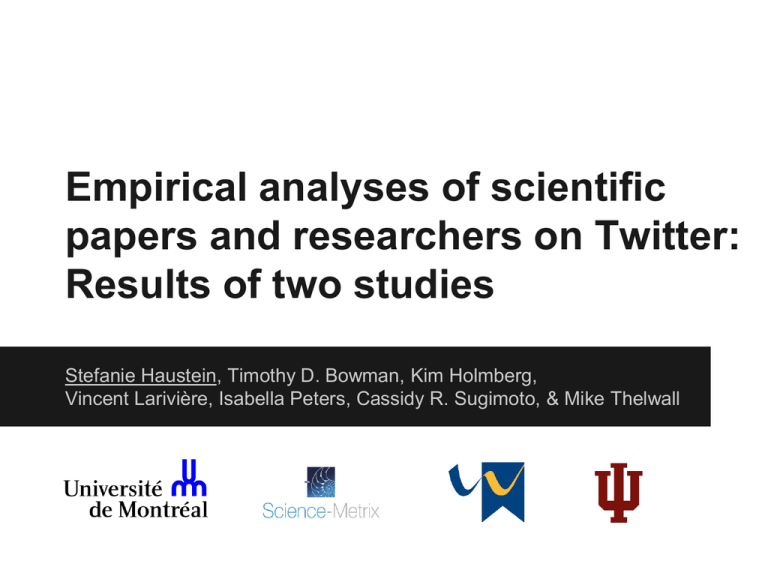
Empirical analyses of scientific
papers and researchers on Twitter:
Results of two studies
Stefanie Haustein, Timothy D. Bowman, Kim Holmberg,
Vincent Larivière, Isabella Peters, Cassidy R. Sugimoto, & Mike Thelwall
Background
• when Garfield created SCI, sociologists of science
analyzed meaning of publications and citations
(Merton, Zuckerman, Cole & Cole, etc.)
• sociological research
• What is it to publish a paper?
• What are the reasons to cite?
• empirical bibliometric research
• disciplinary differences in publication
•
and citation behavior
delay and obsolescence patterns
Background
• empirical studies helped sociologists to understand
structure and norms of science
• for bibliometricians, studies provided a theoretical
framework and legitimation to use citation analysis
in research evaluation
• knowledge about disciplinary differences and
obsolescence patterns helped to normalize statistics
and create more appropriate indicators
Background
• recently social-media metrics have become
important in the scholarly world
• suggestions to complement (or even replace)
citation analysis by so-called ”altmetrics“
• broader audience (not just citing authors)
• more timely
• however, similar to bibliometrics in the 1960s,
little is known about the actual meaning of various
social-media counts
Research questions
•
•
•
•
•
What is the relationship between social-media and
citation counts?
How do various social-media metrics differ?
Why are papers tweeted, bookmarked, liked…?
Who tweets (bookmarks, likes…) scientific papers?
How do these aspects differ across scientific disciplines?
Two case studies on Twitter
• large-scale analysis of tweets of biomedical papers
• in-depth analysis of astrophysicists on Twitter
Study I: Tweeting biomedicine
Aim of the study
•
large-scale analysis of tweets of biomedical papers
• Twitter coverage
• Twitter citation rates (tweets per paper)
• correlation with citations
• discovering differences between:
• documents
• journals
• disciplines & specialties
providing empirical framework to understand the extent
to which biomedical journal articles are tweeted
Haustein, S., Peters, I., Sugimoto, C.R., Thelwall, M., & Larivière, V. (in press). Tweeting biomedicine: an analysis of tweets and citations
in the biomedical literature. Journal of the American Society for Information Science and Technology, http://arxiv.org/abs/1308.1838.
Study I: Tweeting biomedicine
Data sets & methods
•
1.4 million PubMed papers covered by WoS
• publication years: 2010-2012
• document types: articles & reviews
• matching of WoS and PubMed
• tweet counts collected by Altmetric.com
• collection based on PMID, DOI, URL
• matching WoS via PMID
• journal-based matching of NSF classification
• tweets per article, Twitter coverage and correlation
with citations for:
• journals
• NSF disciplines and specialties
Study I: Tweeting biomedicine
Data sets & methods: framework
Study I: Tweeting biomedicine
Data sets & methods: correlations
PY=2010
PY=2011
PY=2012
Study I: Tweeting biomedicine
Results: documents
•
•
Twitter coverage is quite low but increasing
correlation between tweets and citations is very low
Publication
year
Twitter
coverage
Papers
(T≥1)
Spearman's ρ
Mean
Median
Maximum
T2010
C2010
2.4%
13,763
.104**
2.1
18.3
1
7
237
3,922
T2011
C2011
10.9%
63,801
.183**
2.8
5.7
1
2
963
2,300
T2012
C2012
20.4%
57,365
.110**
2.3
1.3
1
0
477
234
9.4%
134,929
.114**
2.5
5.1
1
1
963
3,922
T2010-2012
C2010-2012
Study I: Tweeting biomedicine
Results: documents
Top 10 tweeted documents:
catastrophe & topical / web & social media / curious story
scientific discovery / health implication / scholarly community
Article
Journal
C
T
Hess et al. (2011). Gain of chromosome band 7q11 in papillary thyroid carcinomas of young patients
is associated with exposure to low-dose irradiation
PNAS
9
963
Yasunari et al. (2011). Cesium-137 deposition and contamination of Japanese soils due to the
Fukushima nuclear accident
PNAS
30
639
Sparrow et al. (2011). Google Effects on Memory: Cognitive Consequences of Having Information at
Our Fingertips
Science
11
558
Onuma et al. (2011). Rebirth of a Dead Belousov–Zhabotinsky Oscillator
Journal of Physical
Chemistry A
--
549
Silverberg (2012). Whey protein precipitating moderate to severe acne flares in 5 teenaged athletes
Cutis
--
477
Wen et al. (2011). Minimum amount of physical activity for reduced mortality and extended life
expectancy: a prospective cohort study
Lancet
51
419
Kramer (2011). Penile Fracture Seems More Likely During Sex Under Stressful Situations
Journal of Sexual
Medicine
--
392
Newman & Feldman (2011). Copyright and Open Access at the Bedside
New England
Journal of Medicine
3
332
Reaves et al. (2012). Absence of Detectable Arsenate in DNA from Arsenate-Grown GFAJ-1 Cells
Science
5
323
Bravo et al. (2011). Ingestion of Lactobacillus strain regulates emotional behavior and central GABA
receptor expression in a mouse via the vagus nerve
PNAS
31
297
Study I: Tweeting biomedicine
Results: journals
• 97.7% of 3,812
journals at least
tweeted once
• two-thirds of
journals have
coverage below
20% and Twitter
citation rate < 2.0
• high Twitter citation
rates often caused
by few papers
• high coverage and
Twitter citation rates
for general journals
Study I: Tweeting biomedicine
Results: disciplines
Study I: Tweeting biomedicine
Results: specialties
• specialties differ in
terms of coverage,
Twitter citation rate
and correlations
with citations
• 47 of 61 specialties
bubble size = Twitter citation rate
show low positive,
3 negative and 13
no correlation
Study II: Astrophysicists on Twitter
Aim of the study
•
in-depth analysis of astrophysicists on Twitter
• number of tweets, followers, retweets
• characteristics of tweets: RTs, @messages,
#hashtags, URLs
•
comparison with scientific output
• publications
• citations
• comparison of tweet and publication content
provide evidence in how far astrophysicists on Twitter
use Twitter for scholarly communiation
Haustein, S., Bowman, T.D., Holmberg, K., Larivière, V., & Peters, I., (submitted). Astrophysicists on Twitter: An in-depth analysis of
tweeting and scientific publication behavior. Aslib Proceedings.
Study II: Astrophysicists on Twitter
Data sets & methods
•
•
•
•
•
37 astrophysicists on Twitter identified by
Holmberg & Thelwall (2013)
web searches to identify person behind account
publications in WoS journals
• publication years: 2008-2012
• author disambiguation
Twitter account information
68,232 of 289,368 tweets downloaded and analyzed:
• number of RTs per tweet
• % of tweets that are RTs
• % of tweets containing #hashtags, @usernames, URLs
Holmberg, K., & Thelwall, M. (2013). Disciplinary differences in Twitter scholarly communication. In: Proceedings of ISSI 2013 –
14th International Conference of the International Society for Scientometrics and Informetrics, Vienna, Austria (Vol. 1, pp. 567-582).
Study II: Astrophysicists on Twitter
Data sets & methods
•
•
grouping astrophysicists according to tweeting and
publication behavior
analyzing differences of tweeting characteristics
between user groups
Selected
astrophysicists
tweet rarely
tweet
tweet
(0.0-0.1 tweets occasionally regularly
tweet
frequently
(N=37)
per day)
(3.7-58.2)
do not publish
(0 publications 2008-2012)
publish occasionally
(1-9)
publish regularly
(14-37)
publish frequently
(46-112)
total
(tweeting activity)
(0.1-0.9)
(1.2-2.9)
total
(publishing activity)
--
--
1
5
6
4
3
4
2
13
--
5
5
3
13
1
3
1
--
5
5
11
11
10
37
Study II: Astrophysicists on Twitter
Data sets & methods
•
comparison of tweet and publication content
• extraction of noun phrases from tweets and abstracts
• limited to 18 most frequently publishing astrophysicists
•
•
to ensure certain number of abstracts
analyzing overlap of character strings
calculating similarity with cosine per person and overall
Selected
astrophysicists
tweet rarely
tweet
tweet
(0.0-0.1 tweets occasionally regularly
tweet
frequently
(N=37)
per day)
(3.7-58.2)
publish regularly
(14-37)
publish frequently
(46-112)
total
(tweeting activity)
(0.1-0.9)
(1.2-2.9)
total
(publishing activity)
--
5
5
3
13
1
3
1
--
5
1
8
6
3
18
Study II: Astrophysicists on Twitter
Results: correlations
•
comparison of Twitter and publication activity and impact
• publications and tweets per day: ρ=−0.339*
• citation rate and tweets per day: ρ=−0.457**
• citation rate and RT rate: ρ=0.077
Study II: Astrophysicists on Twitter
Results: characteristics
Mean share of tweets containing at least one user name or
URL per person per group
Study II: Astrophysicists on Twitter
Results: content similarity
•
overall similarity between abstracts and tweets is low
• cosine=0.081
• 4.1% of 50,854 tweet NPs in abstracts
• 16.0% of 12,970 abstract NPs in tweets
• Twitter coverage among most frequent abstract terms is
high, although this differs between users
• 97,1% of 104 most frequent noun phrases on Twitter
Conclusions
•
•
Twitter coverage of biomedical papers is low but increasing
number of tweets per paper varies between journals,
disciplines, specialties and from year to year
tweet counts need to be normalized accordingly
• correlations between tweet and citation counts are low
(biomedical papers) or even moderately negative
(astrophysicists)
tweets cannot replace citations as measures of
scientific impact
challenge is to differentiate between high tweet counts
because of value (to scientists and/or the general public)
and curiosity
Outlook
•
•
user surveys and qualitative research to investigate who is
using scholarly content on social media and why
empirical large-scale studies on other metrics
Haustein, S., Peters, I., Sugimoto, C.R., Thelwall, M., & Larivière, V. (in press). Tweeting
biomedicine: an analysis of tweets and citations in the biomedical literature. Journal of the
American Society for Information Science and Technology.
Haustein, S., Bowman, T.D., Holmberg, K., Larivière, V., & Peters, I., (submitted). Astrophysicists
on Twitter: An in-depth analysis of tweeting and scientific publication behavior. Aslib Proceedings.
Thank you for your attention!
Questions?
Stefanie Haustein
stefanie.haustein@umontreal.ca
@stefhaustein




